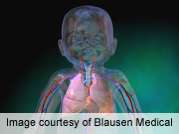Features of microdirect laryngoscopy, bronchoscopy ID'd

(HealthDay)—Neonates undergoing microdirect laryngoscopies and bronchoscopies (MLB) most often present with respiratory distress and stridor, according to research published online Dec. 18 in JAMA Otolaryngology-Head & Neck Surgery.
Kathleen R. Billings, M.D., from the Ann and Robert H. Lurie Children's Hospital of Chicago, and colleagues examined features and findings in neonates undergoing MLB in the first 28 days of life. Data were collected from a retrospective case series of 162 consecutive patients (101 male) aged 28 days or younger.
The researchers found that the mean age at procedure was 14.1 days. Congenital conditions were seen in 62.6 percent of the patients, including congenital cardiac disease (30.2 percent) and syndromic conditions (16.4 percent). Respiratory distress, stridor, and cyanosis or an acute life-threatening event were common indications for surgery (79.7, 56.0, and 36.8 percent, respectively). At the time of surgery, the most common findings were laryngomalacia, subglottic stenosis, and tracheomalacia (39.0, 31.9, and 25.8 percent, respectively). Seventeen and 11 neonates required a tracheostomy and supraglottoplasty, respectively. The likelihood of requiring long-term intubation was increased for patients with congenital heart defects (P = 0.03). Long-term intubation and tracheostomy were more likely among those with syndromic conditions (P = 0.004 and 0.01, respectively).
"Neonates undergoing MLB most commonly presented with respiratory distress and stridor and were most commonly found to have laryngomalacia and subglottic stenosis," the authors write.
More information:
Abstract
Full Text (subscription or payment may be required)
Copyright © 2014 HealthDay. All rights reserved.




















